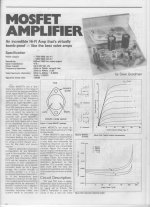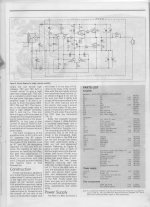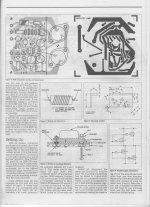Hi!
To understand what I am talking about, please take a look at this photo album that I created:
Mosfet amplifier - Imgur (Highlight a picture and click the little magnifying glass that shows up - to enlarge the pictures significantly.)
What this is:
I found these mono amplifier modules in a discarded movie studio rack, and took them out. They were attached like cartridges to a bigger PCB. There is no mention of them online, that I can find.
They are rated at 120W into 4 ohms, each. I have a whole bunch of them.
Since I do not have the board they were connected to, nor the power supply (they were massive, and strongly bolted into the [even massiver] cabinet), I am not sure how to make use of them. I think there could be vital parts missing, but perhaps not.
Since the boards seem to have their own rectifiers and smoothing caps, I tried soldering a transformer to the two ~ / ~ poles on the rectifier, and speaker terminals to GND and what I assume is the speaker output, and put a multimeter on there. What happened was that DC slowly charged up to 20 volts, and then began dropping again. That is all the testing that I have done. I did not connect a load to it.
There is no idle current or dc offset adjustment on the boards. Is this needed? I've been looking around at schematics for amplifiers using the 2SK135 and 2SJ50 MOSFETs, and it seems that this is very similar to the Crecendo amplifiers from the Elektor magazine in the 80's. Am I wrong?
In conclusion, my main question here is- what can I do with these, and how do I actually plug them in if I want to try playing something on them?
Thank you greatly for your time. 🙂
-C
To understand what I am talking about, please take a look at this photo album that I created:
Mosfet amplifier - Imgur (Highlight a picture and click the little magnifying glass that shows up - to enlarge the pictures significantly.)
What this is:
I found these mono amplifier modules in a discarded movie studio rack, and took them out. They were attached like cartridges to a bigger PCB. There is no mention of them online, that I can find.
They are rated at 120W into 4 ohms, each. I have a whole bunch of them.
Since I do not have the board they were connected to, nor the power supply (they were massive, and strongly bolted into the [even massiver] cabinet), I am not sure how to make use of them. I think there could be vital parts missing, but perhaps not.
Since the boards seem to have their own rectifiers and smoothing caps, I tried soldering a transformer to the two ~ / ~ poles on the rectifier, and speaker terminals to GND and what I assume is the speaker output, and put a multimeter on there. What happened was that DC slowly charged up to 20 volts, and then began dropping again. That is all the testing that I have done. I did not connect a load to it.
There is no idle current or dc offset adjustment on the boards. Is this needed? I've been looking around at schematics for amplifiers using the 2SK135 and 2SJ50 MOSFETs, and it seems that this is very similar to the Crecendo amplifiers from the Elektor magazine in the 80's. Am I wrong?
In conclusion, my main question here is- what can I do with these, and how do I actually plug them in if I want to try playing something on them?
Thank you greatly for your time. 🙂
-C
it looks as single rail amp ; - of Graetz is gnd for entire pcb , and that biggie cap is output one
perfect opportunity to brush your skills in back-engineering - to draw schm from pcb
then post it
perfect opportunity to brush your skills in back-engineering - to draw schm from pcb
then post it
I've thought about doing that, and I will try. It look simple enough, and shouldn't be too hard. Never tried it before, though. 🙂 Thanks guys.
These look like any of several manufacturer's products for pro. sound in the 1980s. Maplin in the UK used to advertise something along those lines in a self-contained module form for many years. Their range was 50-200W IIRC. Don't expect Hi-fi, the keynotes are low cost and reliability. I think they were only required for <0.2% THD.
Last edited:
Me, I'd strip the Mosfets, assuming you have a fairly large number of them, and then acquire or build a suitable driver board - there are a great number that would be suitable and make a very nice up, up to 200w per channel. Or class A at a lower power too...
Of course that is a far more ambitious project then just firing up a pair of modules... shouldn't be too hard... just figure out if it is a single supply rail or not, then you can make the PS.
_-_-bear
Of course that is a far more ambitious project then just firing up a pair of modules... shouldn't be too hard... just figure out if it is a single supply rail or not, then you can make the PS.
_-_-bear
Guys,
I finally got around to playing with these (no schematic yet). Went with my assumptions (thanks to Zen Mod) and connected it up as seemed correct. A wall-wart (12VAC) as temporary power supply to the two ~ pins on the rectifier, followed by a pre-amp and a test speaker. Playing through it now.
This is probably supposed to run at about 50V, so of course it doesn't perform as intended, but it works!
I have a spare transformer that I was planning on using, but it's dual rail. I was thinking...
Could I use it, like this:
One rail and 0 to one of the "blocks", and the other rail plus that same 0 to a second "block"? Would this work? If so - I suppose I'd need to reverse the speaker connectors on one of them, right?
Thanks again.
🙂
I finally got around to playing with these (no schematic yet). Went with my assumptions (thanks to Zen Mod) and connected it up as seemed correct. A wall-wart (12VAC) as temporary power supply to the two ~ pins on the rectifier, followed by a pre-amp and a test speaker. Playing through it now.
This is probably supposed to run at about 50V, so of course it doesn't perform as intended, but it works!
I have a spare transformer that I was planning on using, but it's dual rail. I was thinking...
Could I use it, like this:
One rail and 0 to one of the "blocks", and the other rail plus that same 0 to a second "block"? Would this work? If so - I suppose I'd need to reverse the speaker connectors on one of them, right?
Thanks again.
🙂
I've got the Maplin module schematics in the loft if anyone would like me to post them.
They are not the same as this module as they used +/- supplies and no output cap but they might give you somewhere to start with the reverse engineering.
They are not the same as this module as they used +/- supplies and no output cap but they might give you somewhere to start with the reverse engineering.
It'd work but i think it would be better to run both off the same transformer winding, or have two totally separate windings isolated from each other.
Last edited:
Maplin 150W MOS-FET Amplifier Module
This was a good example of the use of the Hitachi MOS-FETs that gave good and reliable results at low cost.
During 2005 I was actually in negotiations with Maplin to produce a commercial version of this same circuit.
Dollar for Dollar it is PRETTY GOOD.
This was a good example of the use of the Hitachi MOS-FETs that gave good and reliable results at low cost.
During 2005 I was actually in negotiations with Maplin to produce a commercial version of this same circuit.
Dollar for Dollar it is PRETTY GOOD.
Attachments
Last edited:
I can't tell if those are similar in design to mine. I'll try to draw up that schematic later.
I've now connected the transformer as per Tekko's advice. Just using one and the same rail for both amps.
Listening now, it sounds considerably better than with the wal wart (not surprisingly), and I can now play quite loud - no clipping. There is quite a bit of 50Hz hum however, but that is probably caused by my sloppy temporary wiring (speaker wires and power wires are crossed). They're hanging loose right now. Will have to find some wood planks to bolt them to, or something.
They appear to sound rather nice, but it is hard to really say, due to the hum, and because I'm only using my rather poor test speakers (nice drivers but poor cabinet). Don't dare to plug in my primary speakers, yet.
This is fun!
EDIT: Could the lower voltage cause hum? There was none with 12V, but there is with 30. It's probably supposed to run at 45-50V.
EDIT2: I tried playing without a pre-amp and just adjusting the volume with the computer. Worked well, sounded better. But more hum! Then when I unplugged the power cord, there was an increasingly loud sizzle sound, kind of when you pour water into a hot frying pan. Freaky! That did not happen when I used the pre-amp, then it would just turn off with a smooth popping sound.
I've now connected the transformer as per Tekko's advice. Just using one and the same rail for both amps.
Listening now, it sounds considerably better than with the wal wart (not surprisingly), and I can now play quite loud - no clipping. There is quite a bit of 50Hz hum however, but that is probably caused by my sloppy temporary wiring (speaker wires and power wires are crossed). They're hanging loose right now. Will have to find some wood planks to bolt them to, or something.
They appear to sound rather nice, but it is hard to really say, due to the hum, and because I'm only using my rather poor test speakers (nice drivers but poor cabinet). Don't dare to plug in my primary speakers, yet.
This is fun!
EDIT: Could the lower voltage cause hum? There was none with 12V, but there is with 30. It's probably supposed to run at 45-50V.
EDIT2: I tried playing without a pre-amp and just adjusting the volume with the computer. Worked well, sounded better. But more hum! Then when I unplugged the power cord, there was an increasingly loud sizzle sound, kind of when you pour water into a hot frying pan. Freaky! That did not happen when I used the pre-amp, then it would just turn off with a smooth popping sound.
Last edited:
Lower voltage shouldn't cause hum on its own unless you have crap caps. It will however distort badly as it will clip early.
Clipping is bad for speakers so get PSU right before you try good speakers.
Clipping is bad for speakers so get PSU right before you try good speakers.
From what i can tell, those modules have two 1000µF 100V capacitors in series across Vcc and GND, these add up to a total of 500µF, nowhere near enuf filtering.
That's true actually. I didn't think of that. Remembered them as 2200 for some reason, and assumed they were in parallel. 500 - that's ridiculous. What were they thinking?
Puzzling. These are rated at 100V each - why would they be in series?
EDIT: Upon closer inspection, they aren't exactly in series. There's a big resistor (10K, 2 or 3 W), and an LED in between them.
Puzzling. These are rated at 100V each - why would they be in series?
EDIT: Upon closer inspection, they aren't exactly in series. There's a big resistor (10K, 2 or 3 W), and an LED in between them.
Last edited:
They're in parallel.
Easy to see, because traces of both sides are visible : + traces of both lytics are connected in parallel by the fuse holder leads.
I've seen these modules before, even recognise the ECN-CPA4 print, few decades ago, for the likes of me can't recall the rest of the story (the moment to jump off a bridge is due).
Easy to see, because traces of both sides are visible : + traces of both lytics are connected in parallel by the fuse holder leads.
I've seen these modules before, even recognise the ECN-CPA4 print, few decades ago, for the likes of me can't recall the rest of the story (the moment to jump off a bridge is due).
This thread is probably very dead.. But I just have to write this post, since I have two of these amps, AND I know where they come from! B-)
These amps come from a quite obscure, Swedish company that made Cinema soundsystems, and they are called ELA CINEMEKS NORDEN AB 🙂
I also have the L C R speaker boxes and the mono-sub that these amps powered 🙂
These amps come from a quite obscure, Swedish company that made Cinema soundsystems, and they are called ELA CINEMEKS NORDEN AB 🙂
I also have the L C R speaker boxes and the mono-sub that these amps powered 🙂
- Status
- Not open for further replies.
- Home
- Amplifiers
- Solid State
- Mystery MOSFET mono amplifiers with 2SK135 and 2SJ50 - a little help?


